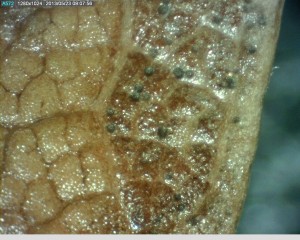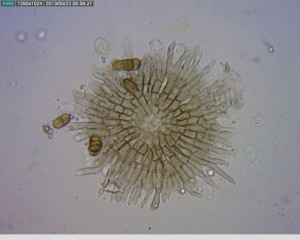The following is a blog post writing assignment from 2013 summer BURS (Bioenvironmental Undergraduate Research Scholar) and BESC 484 student, A. Brake. As previously mentioned, the student is asked to submit a short write up of something that interest them (related to plant pathology) which they may have seen or heard about in the Plant Clinic. They are also highly encouraged to take photographs of subject (training in photo documentation). Ms. Brake submitted a couple of excellent photo with her assignment below where she used a Dino-lite digital eyepiece. Enjoy. -KO
Actinopelte leaf spot on oaks in Texas.
During the hot Texas summer, most enjoy lying out and soaking up the bright sun. However, for plants summer time brings a pool of pathogens. One in particular has a detrimental effect on Oak trees. Tubakia dryina otherwise known as Actinopelte leaf spot is a pathogen most prevalent in red oaks but is still seen in white oaks and other oak variations as well. This disease endures the winter so that the overwintering spores can be dispersed once summer rolls around. The blighted symptoms occur under favorable conditions of moist environments. Usually the symptoms occur mostly at the bottom or within the trunk itself due to those areas being more favorable for the pathogen. Actinopelte is shown on trees that are under immense stress, iron chlorosis being one of the most seen. The leaf spots are necrotic areas that are small, circular, and brownish red in color. The lesions range from 1 to 5 mm in diameter, and some have a yellow halo that surrounds the
infection site. The fruiting structures produced on these lesions are small dark disks, and these spots can spread to the leaf veins where they cause the most damage and death to the leaves. Sometimes this pathogen can be confused with Anthracnose another leaf spot fungus; however the spores are very distinct and can be deciphered under microscopic view. While this disease can cause extensive damage, in most cases it will not defoliate, or completely kill the oak. However some aren’t so lucky, so fungicide treatment is suggested to prevent this infection.*
* note by Dr. Ong: On establish tree, treatment is usually not recommended because the inability and/or ineffectiveness to get good coverage from a spray application. Further, this disease may cause unsightliness but rarely kill the established oak tree.





